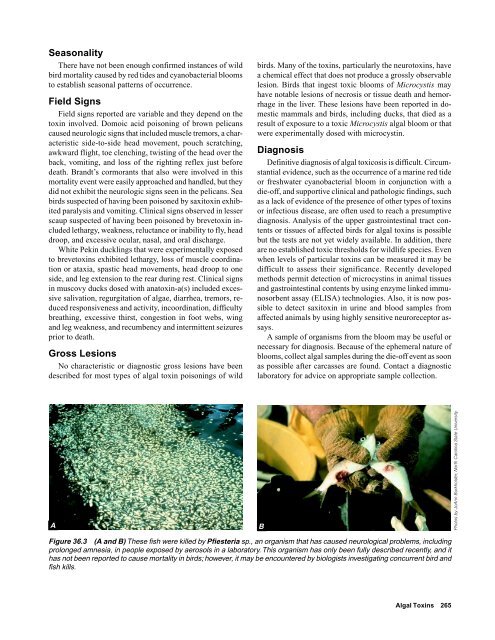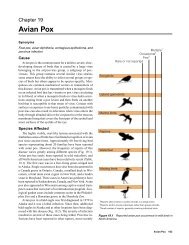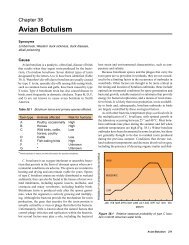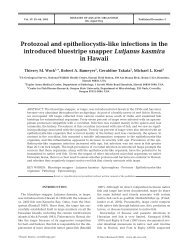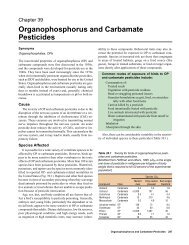Algal Toxins
Algal Toxins
Algal Toxins
You also want an ePaper? Increase the reach of your titles
YUMPU automatically turns print PDFs into web optimized ePapers that Google loves.
Seasonality<br />
There have not been enough confirmed instances of wild<br />
bird mortality caused by red tides and cyanobacterial blooms<br />
to establish seasonal patterns of occurrence.<br />
Field Signs<br />
Field signs reported are variable and they depend on the<br />
toxin involved. Domoic acid poisoning of brown pelicans<br />
caused neurologic signs that included muscle tremors, a characteristic<br />
side-to-side head movement, pouch scratching,<br />
awkward flight, toe clenching, twisting of the head over the<br />
back, vomiting, and loss of the righting reflex just before<br />
death. Brandt’s cormorants that also were involved in this<br />
mortality event were easily approached and handled, but they<br />
did not exhibit the neurologic signs seen in the pelicans. Sea<br />
birds suspected of having been poisoned by saxitoxin exhibited<br />
paralysis and vomiting. Clinical signs observed in lesser<br />
scaup suspected of having been poisoned by brevetoxin included<br />
lethargy, weakness, reluctance or inability to fly, head<br />
droop, and excessive ocular, nasal, and oral discharge.<br />
White Pekin ducklings that were experimentally exposed<br />
to brevetoxins exhibited lethargy, loss of muscle coordination<br />
or ataxia, spastic head movements, head droop to one<br />
side, and leg extension to the rear during rest. Clinical signs<br />
in muscovy ducks dosed with anatoxin-a(s) included excessive<br />
salivation, regurgitation of algae, diarrhea, tremors, reduced<br />
responsiveness and activity, incoordination, difficulty<br />
breathing, excessive thirst, congestion in foot webs, wing<br />
and leg weakness, and recumbency and intermittent seizures<br />
prior to death.<br />
Gross Lesions<br />
No characteristic or diagnostic gross lesions have been<br />
described for most types of algal toxin poisonings of wild<br />
birds. Many of the toxins, particularly the neurotoxins, have<br />
a chemical effect that does not produce a grossly observable<br />
lesion. Birds that ingest toxic blooms of Microcystis may<br />
have notable lesions of necrosis or tissue death and hemorrhage<br />
in the liver. These lesions have been reported in domestic<br />
mammals and birds, including ducks, that died as a<br />
result of exposure to a toxic Microcystis algal bloom or that<br />
were experimentally dosed with microcystin.<br />
Diagnosis<br />
Definitive diagnosis of algal toxicosis is difficult. Circumstantial<br />
evidence, such as the occurrence of a marine red tide<br />
or freshwater cyanobacterial bloom in conjunction with a<br />
die-off, and supportive clinical and pathologic findings, such<br />
as a lack of evidence of the presence of other types of toxins<br />
or infectious disease, are often used to reach a presumptive<br />
diagnosis. Analysis of the upper gastrointestinal tract contents<br />
or tissues of affected birds for algal toxins is possible<br />
but the tests are not yet widely available. In addition, there<br />
are no established toxic thresholds for wildlife species. Even<br />
when levels of particular toxins can be measured it may be<br />
difficult to assess their significance. Recently developed<br />
methods permit detection of microcystins in animal tissues<br />
and gastrointestinal contents by using enzyme linked immunosorbent<br />
assay (ELISA) technologies. Also, it is now possible<br />
to detect saxitoxin in urine and blood samples from<br />
affected animals by using highly sensitive neuroreceptor assays.<br />
A sample of organisms from the bloom may be useful or<br />
necessary for diagnosis. Because of the ephemeral nature of<br />
blooms, collect algal samples during the die-off event as soon<br />
as possible after carcasses are found. Contact a diagnostic<br />
laboratory for advice on appropriate sample collection.<br />
A<br />
B<br />
Photos by JoAnn Burkholder, North Carolina State University<br />
Figure 36.3 (A and B) These fish were killed by Pfiesteria sp., an organism that has caused neurological problems, including<br />
prolonged amnesia, in people exposed by aerosols in a laboratory. This organism has only been fully described recently, and it<br />
has not been reported to cause mortality in birds; however, it may be encountered by biologists investigating concurrent bird and<br />
fish kills.<br />
<strong>Algal</strong> <strong>Toxins</strong> 265


